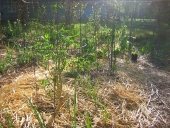





Abe Connally wrote:The US throws away more than half of the food/biomass it produces. So, right there, if we managed our waste streams in a better way, we could support 50% more people on the exact same land and inputs that we are currently using.

"pulsing of the predator-prey-pruning cycle on perennial prairie polycultures"

R wannabe wrote:Any one that says 'X is the ONLY way' is stupid, ignorant, or has an agenda.
All ecosystems are LOCAL!!! What works for me doesn't work for my friends down the road, let alone a whole nation or the world all doing the same thing. What worked a thousand (or hundred or even ten) years ago might not work today as we have changed the ecosystem by our presence.
As far as the local vs. transport thing--it isn't so easy. If you grow that food where it grows best and then transport it, it could be less total input than if you try to grow it local in a less than ideal growing region. Local can add resilency to the food supply--whether it is from fuel shortages or large crop failures--but it is hard to feed a city either way. It isn't an easy thing to balance on the national/world scale.

greg patrick wrote:OK, I'll bite. I don't see planting yams and spreading compost over hundreds of millions of acres as a viable option. I will admit that the area under my deciduous trees is pretty mulchy and nice, but taking acreage offline for a generation isn't necessarily a great option either when running cattle over grass would provide food and restore the land immediately.
How else?

